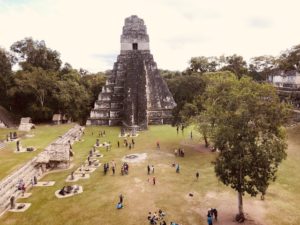
Tikal’s Temple I rises to a height of 154 feet (47 meters). Photo by Robert Waite.
For those planning their post-COVID travels, or who just like a good read, our roving contributing writer Robert Waite sets foot this time in the fabulous Mayan ruins of Tikal and Yaxha, which flourished two millennia ago in the jungles of what is now Guatemala.
It was the New York of its day, a massive complex complete with “skyscraper” temples, plazas, and palaces. When it seems safe to go, you may well want to add it to your future travel plans.
By Robert Waite
Tikal, Guatemala – Anyone who still buys into the myth that the Americas needed to be discovered by Columbus to be “civilized” has not wandered among the pyramids or across the expansive plazas of Tikal.
Beginning around 350 B.C. and stretching into the 5th century A.D., at a time when Europe was sliding into what eventually became the Dark Ages, the Central American Maya peoples were constructing one of the largest, most sophisticated urban areas on the planet. Carved out of the Petén Basin lowland rain forest in what is now Guatemala, it once had a footprint larger than ancient Rome or Beijing.
Population estimates vary widely, depending on the time frame (and the person estimating): anywhere from 10,000 to 90,000 inhabitants.
And then, sometime in the 9th century A.D., Tikal all but disappeared, as Mayan civilization fell into disarray. Soon the rain forest reclaimed the cleared land, leaving only the pinnacles of a few pyramids poking out of the canopy.
Which is not to say Tikal was ever completely forgotten – the area continued to be populated by the descendants of Mayan forebears and they were happy to lead Europeans, starting with Spanish Friar Andes de Avendano in 1696, to the site.
Much Still Buried
It was only in the mid-20thcentury, however, that serious archaeological study and excavation began, under the auspices of the University of Pennsylvania and the national government. Today, many acres of plazas, pyramids and tombs have been unearthed – although aerial photos and imaging indicate this cleared area represents only 10 percent of what once was.
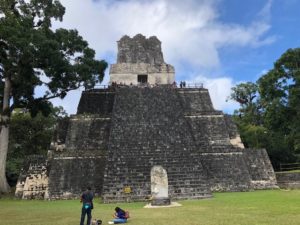
Tikal’s Temple II or “Temple of the Masks.” You can climb it for a panoramic view if you don’t have mobility problems. Photo by Robert Waite.
My interest in Tikal dates back to the 1970’s, when I first visited Chichen Itza in Mexico’s Yucatan. Impressed, I dove into C. Bruce Hunter’s classic “Guide to Ancient Maya Ruins” and learned that a site far more impressive lay to the south.
A reading of the late Ronald Wright’s “Time Among the Maya” and a subsequent return visit to Chichen Itza with family in 2002 only further whetted my appetite.
The problem, of course, was Guatemala – specifically safety and security. The country has experienced long stretches of civil strife, including banditry and guerilla activity. Not exactly a recipe for a relaxing family trip – or a Boomer vacation.
While things today are still somewhat problematic – the U.S. State Department lists the country as Level 3 (Reconsider Travel) – if you are careful, engage a reputable travel firm and restrict yourself to secure areas, you should be fine.
In our case, we entered and exited the country from Belize and contracted the services of GEM Guatemala Travel, a company that can seamlessly handle the sometimes sticky border crossing. (Guatemala claims the lower third of Belize, right to the Caribbean shore. This does not make for friendly relations.)
Billboard Border War
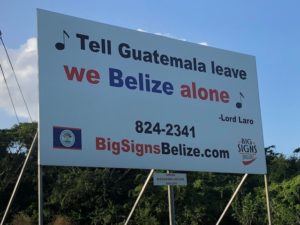
Billboards display Belize-Guatemala border tensions. Photo by Robert Waite.
It takes the better part of a day to reach Tikal from Belize City. But the day is not wasted – on the drive you’ll be entertained by the “Hands Off Belize!” billboards aimed at Guatemala and, once you get to your lodgings at Tikal, you can enjoy a mid-afternoon lunch, followed by a sunset tour of the World Heritage site.
There are two reasons you might want to wander over to Tikal late in the day. First, it is cooler. Second, the light casts shadows that accentuate the relief carving patterns.
Our guide was Omar Alvarado, a knowledgeable but easy going fellow who didn’t try to overwhelm you with superfluous detail. He did, however, drive home the fact that the complex is huge – and that what we were seeing was only a small fraction of what still lay beneath.
We took a leisurely stroll past Temple VI, the Palace of the Grooves, Temple V (we never did figure why the Penn archaeologists were so fond of Roman numerals), the plaza of the Seven Temples, the Lost World Complex, and then climbed to the top of the Great Pyramid to be there at precisely 6:04 pm to see the sun set.
It was spectacular.
The Sun Also Rises
In retrospect, I think of this as a kind of appetizer – a starter course, not too filling (or exhausting). At dawn we would begin again.
Because once you’ve seen the sun set, you need to see it rise. Or so we were advised.
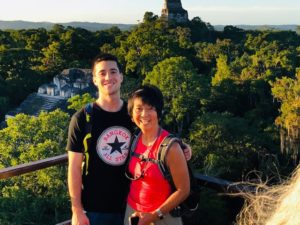
The author’s wife and son enjoy sunset at Tikal. Photo by Robert Waite.
With that in mind, we rose at 4:30 am, hiked with Omar to Temple IV and climbed some stairs to a kind of portico perched well above the tree line, eventually joining two dozen other sleepy-looking tourists.
We found a seat and waited with great anticipation.
What we saw, as the sun presumably was peaking above the horizon, was … fog. Not a light mist; not a patch of fog, but sunbeam-strangling, London-in-the-‘50’s fog. You win some, you lose some; and some get fogged out.
But the early start had as its great advantage the avoidance of mid-day heat – and mid-day crowds.
After a picnic breakfast we made our way to the main Tikal sites, including the Temple of the Jaguar Priest, Complex N, the Palace of the Windows and the Central Acropolis.
True Lies?
Every temple tells a story, as does every palace. How many of them are accurate and how many are pure conjecture?
Who knows; but Omar related what seemed to be the most plausible theories. It seems certain, for example, that the Central Acropolis was a palace complex and that the North Acropolis had a burial function.
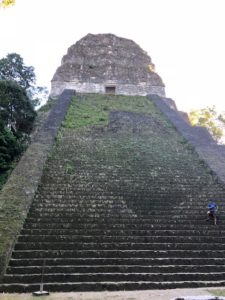
Tikal’s pyramid-shaped Temple V. Only about 10 percent of the entire site has been uncovered to date. Photo by Robert Waite.
And you’re not done with climbing – you can ascend the stone steps of the Temple of the Masks, a.k.a Temple II, one of the better preserved structures. From the top you get a good panoramic view.
But a word of warning – while much of what Tikal offers is accessible, those with mobility issues or suffering from some form of vertigo will likely want to refrain from summiting the pyramids.
Omar returned us to our lodgings around 11 am. After a pleasant lunch on the veranda, we poked around Tikal on our own during the afternoon.
A more leisurely pace allowed time to study the inscriptions on various buildings and tablets and to marvel at the gigantic cypress and other tree species dotting the landscape — a good way to end our stay here.
Up Next: Our correspondent heads to another ancient Mayan complex, Taxha, where he would encounter wailing howler monkeys, ball courts where the winners may or may not have been sacrificed, and the lasting legacy of TV’s “Survivor Guatemala.”
Author Bio: Contributing writer Robert Waite has written on travel for nearly 50 years; his previous posts for clarknorton.com include such far-flung destinations as Namibia, Rwanda, Albania, Cambodia (Angkor Wat), and Laos. He is also a professor at Seneca College in Toronto and Managing Partner at Waite + Co., a communications consulting firm with offices in Boston, Ottawa and Toronto.












9 Responses to Tikal Your Travel Bone at Iconic Mayan Site